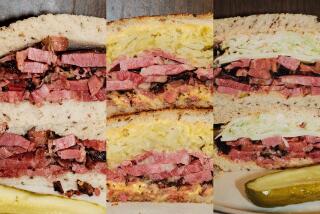Say Cheese: Ode to the #16 Plate
- Share via
It is nothing short of perfection: a blend of tender grilled pork, a generous portion of melted Monterey Jack cheese and a chopped poblano chile, guaranteed to provide just the right amount of kick.
My mind flashed on this heavenly concoction--and my mouth watered for it--as I read Dagoberto Gilb’s ruminations on the state of Mexican food in the U.S., fare that has become, in his words, “American now.” Having long ago been bastardized by our fast-food nation, the taco is “like spaghetti that really isn’t very Italian,” he writes, “like French bread that isn’t French” (“Taco Bell Nation,” page 24).
Gilb remembers with what seems a mix of nostalgia and nausea the classic #3 combination “at every local authentic Mexican restaurant 50 years ago,” a meal so glutinous that the beans and enchiladas would cling to the plate like Superglue.
My own favorite is not the #3 but, rather, the #16, as described above and served with handmade tortillas at Santa Barbara’s La Super-Rica, a little joint on Milpas Street that the late Julia Child famously adored. I’m not exactly sure if the #16 would fuse and hold fast if you turned it upside down. It’s pretty viscous, though, thanks to all that Monterey Jack.
Menus weren’t always like this. David Hayes-Bautista, director of UCLA’s Center for the Study of Latino Health and Culture, says that until the 1950s, Mexican cuisine in the U.S. consisted mainly of red meat and pintos--”almost like Tex-Mex cookery”--because most immigrants hailed from relatively close to the border, and those were the primary ingredients back home. Not a lot of cheese was used.
But then two things happened. First, Mexicans began to stream in from regions farther south such as Oaxaca, where dairy products are a more common part of the diet. In fact, Isidoro Gonzalez, the owner of La Super-Rica, says the inspiration for the cheesy selections at his restaurant are the taquerias of Mexico City.
Second, Mexican food has gotten more and more Americanized over time--heavily processed and accompanied by gobs of sour cream, guacamole and chips.
The consequences are not insignificant. A recent report from the United Way of Greater Los Angeles found that more than two-thirds of the adults in the Latino community here are overweight or obese. Hayes-Bautista, who worked on the study, says the problem is particularly severe among third- and fourth-generation Mexican Americans and, of course, is not limited to those in California. Along the Texas border, he says, “you can tell a Tejano family from a Mexican one” because “the clothing size is nearly double.”
In the end, Gonzalez offers the only course that makes sense, even at a place like his, where all the food is fresh: “Just eat in moderation,” he suggests. When it comes to the # 16, however, that’s easier said than done.
More to Read
Eat your way across L.A.
Get our weekly Tasting Notes newsletter for reviews, news and more.
You may occasionally receive promotional content from the Los Angeles Times.










